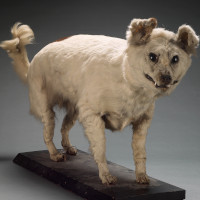 |
Kuri |
|
He is not recognized by the F.C.I. |
Origin |
New Zealand, between "Waikava" & Mataura plains, Catlins | |
Translation |
Francis Vandersteen | |
This breed is also known as |
Maori dog |
| Kurī, or Pacific dog, were a unique breed, brought to Aotearoa New Zealand by ancestors of Māori. These animals were prized – not necessarily as friends, but as valuable provisions. The meat was a delicacy, the pelts made into cloaks that could only be worn by rangatira (leaders), the teeth fashioned into ornaments, and the bones made into matau (fishhooks). They even appear in early Māori art, in charcoal-rendered drawings found on rock overhangs in the South Island. Early Europeans settlers recognised them as a distinct breed. Europeans also brought their own breeds of dog and this spelled the end of the kurī. Interbreeding meant that kurī eventually no longer existed as a separate breed. Many were also shot by early run holders to protect livestock. This kurī was shot along with her pup by a farmer in 1867, and is one of only a few taxidermised kurī in existence, therefore a valuable record. Its poor condition is due to the fact that some time had elapsed between the animal being killed and it being mounted. Her pup was sent to the British Museum. From the journal Transactions of the New Zealand Institute; vol 9; 1876 : "A bitch and full- grown pup were known for several years in the densely wooded country between Waikava [Waikawa] and the Mataura plains, and did great damage among the flocks of sheep, but exhibited such cunning and daring that it was not till after hunting them for two years that they were shot by Mr Anderson, who presented them to the Colonial Museum. Of the smaller specimen both skin and skeleton were taken to the British Museum by Sir Grey, and the skin of the mother was preserved here, and has been recognized by many old Māoris as a genuine Kurī or ancient Māori dog" "The skull, which is the only part of the skeleton preserved, proves it to have been a very old individual, the canines being worn down to their stumps, and the processes and ridges of the cranium strongly developed" |







 English (United Kingdom)
English (United Kingdom)